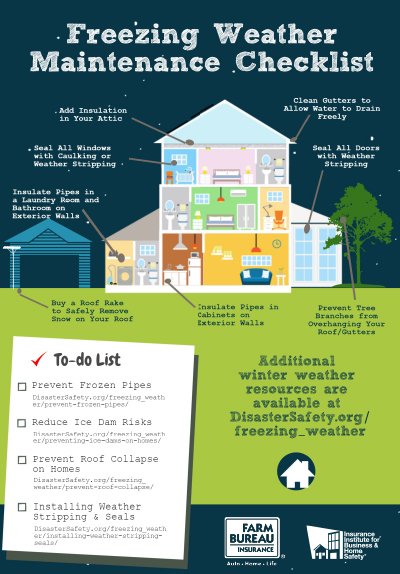Follow the steps below and download the "Freezing Weather Maintenance Checklist" to protect your home and your wallet from the harsh reality of Mother Nature.
 Step 1: Check the location and condition of your home’s pipes to ensure they are protected.
Step 1: Check the location and condition of your home’s pipes to ensure they are protected.
Frozen pipes are the number one cause of property damage during the winter months. A frozen pipe can lead to pipes bursting, which can cause more than $5,000 in water damage according to the Institute for Business and Home Safety. Homes built on slab foundations frequently have pipes in the attic, an especially vulnerable location. Pipes located in crawl spaces and outside walls are all subject to freezing and bursting. If the pipes are not properly insulated or heated, a strong overnight freeze can spell disaster. Protect your home’s pipes from freezing weather by:
- Sealing all openings where cold air can get at unprotected pipes.
- Adding pipe insulation in vulnerable locations. This includes pipes in cabinets on exterior walls. Pipe insulation can be purchased at your local hardware store for as little as .50 per linear foot.
- Leaving cabinet doors open under kitchen and bathroom sinks when temperatures dip below freezing.
- Allowing faucets to drip slowly during freezing weather to keep water flowing through pipes. An open faucet allows water to escape preventing pressure from building which causes the pipe to burst. If the dripping stops, keep the faucet open since the pipe still needs pressure relief.
- Draining outside pipes and enclosing exterior pipes in two-inch fiberglass insulation sleeves.
- Draining and storing outdoor hoses. Shut off outdoor water valves in cold weather.
Step 2: Perform routine maintenance around your home.
- Clean gutters to allow water to drain freely and away from your home.
- Trim tree limbs away from the home.
- Inspect your roof; this is your first line of defense against water intrusion. Ice, rain, wind and snow combined with rapidly changing temperatures and humidity all take a toll on your roof. It’s better to proactively make needed repairs now than to discover a leak in the middle of a winter storm.
- Check the foundation for cracks and caulk where the masonry meets siding, where pipes or wires enter the home, and around windows and door frames.
- Make sure your woodstove or fireplace is in working order. Check the damper to ensure it opens and closes properly. Check the flue to make sure it’s free of obstructions. Look for missing mortar or cracks in the firebox. Have your fireplace cleaned of creosote build-up every other year by a licensed chimney sweep.
Step 3: Review your homeowners policy with your Farm Bureau Insurance agent.
- Don’t be caught off guard by repair costs. Talk with your Farm Bureau Insurance agent to make sure you have the coverages you need and to review your policy deductible.
To stay ahead of the cold, download your own Freezing Weather Maintenance Checklist.
For insurance questions, you can reach a customer service representative at 1-800-799-7500 or find an agent online at www.SCFBIns.com.